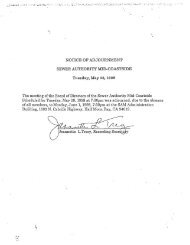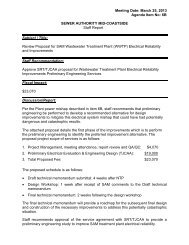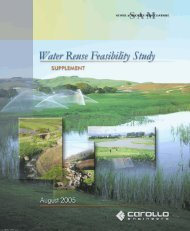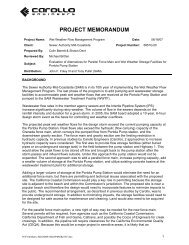Pilarcitos Integrated Watershed Management Plan - San Mateo ...
Pilarcitos Integrated Watershed Management Plan - San Mateo ...
Pilarcitos Integrated Watershed Management Plan - San Mateo ...
You also want an ePaper? Increase the reach of your titles
YUMPU automatically turns print PDFs into web optimized ePapers that Google loves.
<strong>Pilarcitos</strong> <strong>Integrated</strong> <strong>Watershed</strong> <strong>Management</strong> <strong>Plan</strong><br />
improvement in the <strong>Pilarcitos</strong> watershed hinge upon the ability to improve summer and fall<br />
instream flows in the lower watershed.<br />
4.2.1 Instream Flow Improvement Opportunities<br />
The Restoration <strong>Plan</strong> concluded that the most limiting factor to steelhead population was low<br />
streamflow resulting from water diversion, which hinders adult spawning migration, smolt outmigration,<br />
and juvenile rearing conditions. Although the fishery assessments reported in the<br />
Restoration <strong>Plan</strong> were performed in a wet year (1995), summer stream flows were still low<br />
enough to limit steelhead abundance throughout the watershed.<br />
Summertime instream flow conditions in Lower <strong>Pilarcitos</strong> (Figure 1) have been significantly<br />
lower than other creeks along the central coast. Retention of water at <strong>Pilarcitos</strong> Lake and its<br />
diversion at Stone Dam eliminated a significant portion of the contributing watershed area. Base<br />
flows from tributary basins have been insufficient to compensate for the lack of water from Upper<br />
<strong>Pilarcitos</strong>. Prior to 1997, it was not uncommon for <strong>Pilarcitos</strong> Creek at Half Moon Bay to be dry<br />
for 30 or more days each year. After 1998, a minimum flow level has been maintained throughout<br />
the year, although the volume of flow in summer has remained low.<br />
The 2007 summer flows in Lower <strong>Pilarcitos</strong>, as measured at Half Moon Bay by the USGS,<br />
generally have exceeded the 80 th percentile of historic summer flows for this station over its 40<br />
years of record. This trend occurred despite the otherwise dry conditions along most of the other<br />
coastal streams. The source of this additional water can be traced back to releases below Stone<br />
Dam, which are two to four times higher in 2007 than they have been over the last 10 years (the<br />
period of record below Stone Dam). The improved 2007 flow conditions, as well as improved<br />
lagoon conditions, offer a perspective for opportunities to improve instream flows.<br />
4.2.2 Water Supply Infrastructure<br />
The SFPUC operates reservoir facilities in the upper <strong>Pilarcitos</strong> watershed. The facilities include<br />
<strong>Pilarcitos</strong> Reservoir, Stone Dam, water conveyance pipelines and tunnels, various buildings and<br />
roads. The SFPUC owns the land comprising the upper watershed of <strong>Pilarcitos</strong> Creek and the<br />
stream corridor from Stone Dam Reservoir extending downstream approximately one mile.<br />
SFPUC controls access to these lands to protect water quality and has managed the upper<br />
watershed for a number of environmental benefits. EOA (1990) indicated that SFPUC diversions<br />
capture 28 percent of the total watershed runoff, the largest amount among existing water users.<br />
The CCWD serves the City of Half Moon Bay and a part of the unincorporated area of <strong>San</strong> <strong>Mateo</strong><br />
County including Miramar, Princeton by the Sea and El Granada. The District's service territory<br />
encompasses approximately 14 square miles and serves nearly 18,000 people. CCWD has three<br />
<strong>Watershed</strong> Assessment Summary 17 October, 2008








